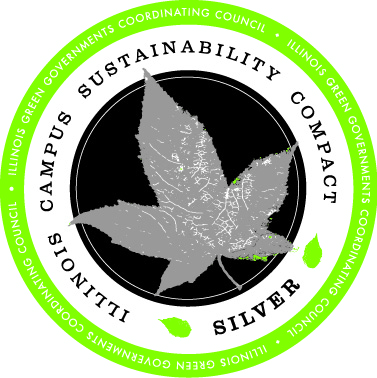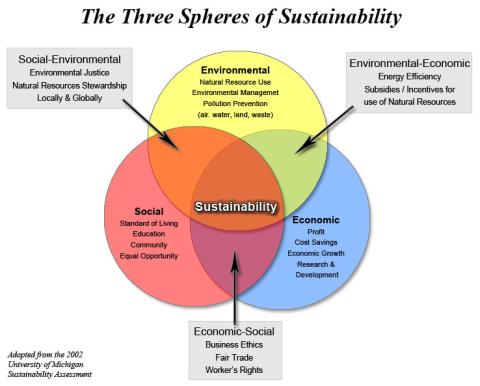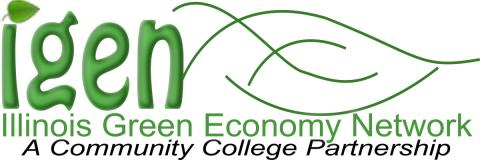
Initiatives
Green Initiatives
- Governor's Compact
-
Program Overview
Welcome to the Illinois campus Sustainability Compact. The goal of the compact is to encourage universities and colleges within the state to incorporate sustainability Into their campus operations, academic and research programs, student activities and community outreach. An institution may pledge at any level provided It has Implemented a sustainability program that meets the preceding requirements. The institution may remain at a participation level as long as it continues to make progress toward its commitments. If the institution achieves each of the goals for a given level, it may apply for higher recognition level at any time. As a compact participant, an institution is expected to report annually to the GGCC on the progress it Is making toward achieving the program goals.
Click here for the full Compact Agreement
DACC has achieved the silver standard recognition level of sustainability goals- {C}
- Rain Water Collection System
-
Danville Area Community College, in its continuing sustainability effort, installed a revolutionary RainXchange System for capturing, filtering, and re-using rainwater on the DACC campus. Installed in July 2011 at the DACC Greenhouse, the RainXchange System collects rainwater to subsidize water usage for watering greenhouse plants and turf greens.
The RainXchange System combines a decorative bubbling rock water recirculation feature with a sub-surface rainwater harvest storage system, capable of holding 1000 gallons of rainwater. The RainXchange system stores the collected water underground to maintain the integrity and beauty of the landscape. By reusing rainwater, the College will reduce water bills which include sewer charges and will alleviate demand on municipal water systems. Rainwater is extremely rich in nutrients to irrigate landscape, reducing the need for fertilizer and chemicals. Finally, reusing rainwater limits the waste of the planets’ freshwater resources through usage and pollution.
The rainwater collection system was funded by a $5,000 grant from the Illinois Green Economy Network (IGEN). IGEN is a partnership of 48 community colleges working to grow Illinois’ green economy, providing employment opportunities and healthy communities for all. IGEN is a continuously growing network of community colleges looking to develop a new kind of partnership with each other, with local employers, and within their communities. The purpose of the network is to combine the power of community colleges, businesses and the local community to stimulate the states’ green economy by focusing on the critical problems we can solve together, but cannot solve alone.
- Tobacco Free Campus
-
DACC is committed to providing its staff and students with a safe and healthy environment. To this end, Danville Area Community College will be a tobacco-free campus as of August 1, 2012. Reasons we are moving toward a tobacco-free campus include:
- The exposure to second-hand smoke at building entrances and exits
- The desire to ensure clean air for all who come to campus
- The presence of underage students on campus
- Tobacco litter throughout campus grounds
Click here to read more about DACC's Tobacco Free Campus Initiative
- LCD Monitors
-
Throughout campus DACC has installed numerous LCD monitors to display upcoming events and important dates/meetings for students and bring awareness to campus/community events. To further DACC sustainability efforts, periodic “Green Bytes” are displayed to bring awareness to recycling, climate and environmental impacts.
- Hydration Stations
-
The DACC Sustainability Center is excited to announce the installation of five new “hydration stations” on campus, bringing the total number of stations on campus to six! Thanks to a grant from the Illinois Green Economy Network students, faculty and staff have free access to filtered water and the college is able to reduce its environmental impact by limiting the amount of waste created by single use water bottles. The water bottle refill stations resemble traditional water fountains but have an additional “shelf” area to set your bottle for no-touch refilling in less than ten seconds. In addition, the refill stations provide a count of the number of water bottles that have been averted from the landfill. There is a ticker on each station with a message that reads: “Helped eliminate waste from XXXX disposable plastic bottles.” Since installation last fall and this month, DACC has eliminated over 13,600 plastic bottles from the landfill. Next time you are thirsty, grab your environmentally friendly reusable water bottle and refill it at one of the following locations on campus. What you do matters: save your money, save our planet and save your health!
Mary Miller Center (3 locations) - East Side of MM GYM (parking lot side) near restrooms; West Side of MM GYM (campus side) near restrooms and Lower Level of MM near racketball court entrances and restrooms
Technology Center - near restrooms and vending machine area
Student Union - near vending machines
Clock Tower Center - near entrance on North end of building next to elevator
Sustainability Initiatives

- What is Sustainability?
-
What is meant by Sustainable Development and Sustainability?
In 1987, The World Commission on Environment and Development chaired by the Prime Minister of Norway, Mrs Gro Harlem Brundtland, published a report Our Common Future (The Brundtland Report) which brought the concept of sustainable development onto the international agenda. It also provided the most commonly used definition of sustainable development describing it as:
"Development which meets the needs of the present without compromising the ability of future generations to meet their own needs"
This principle has been incorporated in the Maastricht and Amsterdam Treaties on European Union, as well as in the Rio Declaration and Agenda 21, adopted by the United Nations Conference on Environment and Development (UNCED), meeting in Rio de Janeiro 3 to 14 June 1992. The European Community and its Member States subscribed to the Rio Declaration and Agenda 21 and committed themselves to the rapid implementation of the principal measures agreed at UNCED.
Image Media Category
Media CategoryThe Bruntland report described seven strategic imperatives for sustainable development: reviving growth; changing the quality of growth; meeting essential needs for jobs, food, energy, water and sanitation; ensuring a sustainable level of population; conserving and enhancing the resource base; reorienting technology and managing risk; merging environment and economics in decision-making.
It also emphasized that the state of our technology and social organization, particularly a lack of integrated social planning, limits the world's ability to meet human needs now and in the future
Principles of Sustainability:
- Recognize your ability to act sustainably in all you do
- Play an active role in promoting more sustainable practices
- Through education, promote a behavioral change which exemplifies sustainable practices
- Do not compromise the possibilities of future generations through unsustainable activities
- Encourage consideration of alternative and more sustainable solutions, strategies and perspectives in addressing concepts, problems or issues in business, government and communities.
Guiding steps towards sustainability:
- Develop an environment which supports human dignity through gender and racial equality and promotes intergenerational respect.
- Develop honesty and integrity in daily life.
- Encourage the fair distribution of wealth.
- Work to strengthen local communities and safeguard the health and safety of all.
- Commit to maintaining and enhancing the integrity and biodiversity of the natural environment
- Use natural resources, such as water and land wisely and aim to reduce consumption.
- Refuse, reduce, reuse, repair and recycle.
- Where possible buy “green” products, locally produced with reduced packaging.
- Understand the synergies between advances in technology and behavioral change to achieve sustainability.
- Encourage ethical business practices.
- Develop business strategies which promote good corporate governance.
- Encourage financial success through openness and transparency.
- Take Action!
-
Take Action! is designed for students, faculty/staff, and the community in which Danville Area Community College touches to provide sustainable practices and a source for innovation.
- Looking for ways to green up your activities?
- Tired of affecting the environment in a negative or apathetic way?
- Searching for a place to share your ideas?
Look no further!
Sustainability helps preserve this beauty for future generations.
Topics Discussed:
- Resources for Greening up your home and office
THE PROBLEM
On the average, Americans waste as much energy as two-thirds of the world's population consumes. That's largely the result of driving inefficient cars, using inefficient furnaces and appliances, and living and working in poorly insulated buildings.
WHAT YOU CAN DO
Buy energy-efficient products
When buying new appliances or electronics, shop for the highest energy-efficiency rating. Look for a yellow and black Energy Guide label on the product. It compares the energy use for that model against similar models. New energy-efficient models may cost more initially, but have a lower operating cost over their lifetimes. The most energy-efficient models carry the Energy Star label, which identifies products that use 20-40 percent less energy than standard new products. According to the EPA, the typical American household can save about $400 per year in energy bills with products that carry the Energy Star. Did you know your refrigerator typically accounts for 20 percent of your electric bill? On the average, new refrigerators and freezers are about 75 percent more efficient than those made 30 years ago, so investing in a state-of-the-art refrigerator can cut hundreds of dollars from your electric bill during its lifetime.
Switch to compact fluorescent bulbs
Change the three bulbs you use most in your house to compact fluorescents. Each compact fluorescent bulb will keep half a ton of carbon dioxide out of the air over its lifetime. And while compact fluorescents are initially more expensive than the incandescent bulbs you're used to using, they last ten times as long and can save approximately $30 per year in electricity costs.
Set heating and cooling temperatures differently
Check thermostats in your home to make sure they are set at a level that doesn't waste energy. Get an electronic thermostat that will allow your furnace to heat the house to a lower temperature when you're sleeping and return it to a more comfortable temperature before you wake up. In the winter, set your thermostat at 68° in the daytime and 55° at night. In the summer, keep it at 78°. Remember that water heaters work most efficiently between 120° and 140°. In your refrigerator, set the temperature at about 37°and adjust the freezer to operate at about 3°. Use a thermometer to take readings and set the temperatures correctly.
Turn off the lights
Turn off lights and other electrical appliances such as televisions and radios when you're not using them. This is a no-brainer, but it's surprising how many times we forget. Install automatic timers for lights that people in your house frequently forget to flick off when leaving a room. Use dimmers where you can. Remember to turn off your computer monitors also when not in use.
Use your appliances more efficiently
The way you use an appliance can change the amount of energy it wastes. Make sure your oven gasket is tight, and resist the urge to open the oven door to peek, as each opening can reduce the oven temperature 25°. Preheat only as much as needed, and avoid placing foil on racks -- your food won't cook as quickly. Your second biggest household energy user after the fridge is the clothes dryer. Dryers kept in warm areas work more efficiently. Clear the lint filter after each load, and dry only full loads. And don't forget that hanging clothing outside in the sun and air to dry is the most energy-efficient method of all.
Check your utility's energy-efficiency incentives
Some utility companies have programs that encourage energy efficiency. Check with your utility to find out if it offers free home energy audits, cash rebates for using energy-efficient lighting and appliances, and lower electric rates for households meeting certain energy-efficiency criteria.
Weatherize your home or apartment
Drafty homes and apartments allow energy dollars to leak away. Seal and caulk around windows and doors. Make sure your home has adequate insulation. Many old homes do not have enough, especially in the attic. You can check the insulation yourself or have it done as part of an energy audit.
Choose renewable energy
Many consumers can now choose their energy supplier. If you have a choice, choose an electric utility that uses renewable power resources, such as solar, wind, low impact hydroelectric, or geothermal.
Let the sun shine in
The cheapest and most energy-efficient light and heat source is often right outside your window. On bright days, open blinds, drapes, and shutters to let the sun light your home for free. Also remember that sunlight entering a room equals passive solar heating. Even on cold winter days, sun streaming into a room can raise the temperature several degrees.
- Sustainability Work Group
-
The Sustainability Working Group (SWG) is open to DACC faculty, staff, and students. The goal of the group is to keep sustainability issues on the forefront of people’s minds at DACC. This group works in tandem with the Sustainability Steering Committee and is project- and action-oriented.
- IL Green Economy Network
-
Illinois Green Economy Network (IGEN) is a collaborative initiative to develop and promote sustainable programs across all 48 Illinois community colleges through curriculum, economy, employment opportunities and campus development.
DACC will be working collaboratively with Highland CC to develop a hybrid wind energy technician program. This three year project is funded by the U.S. Department of Labor Trade Adjustment Assistance Community College and Career Training grant.
Image Media Category
Media Category - Community Involvement
-
Danville Area Community College understands that for students to prosper they need to succeed both in academia and through community involvement. This is so true in a setting such as Vermilion County where our graduates directly influence the future of our great community. To further foster this understanding DACC has undertaken several initiatives/projects to create a sense of pride in the community.

